 Allard Munters, PE1NWL
Allard Munters, PE1NWL![]() Click
here to see the original faxed license!
Click
here to see the original faxed license!
In a period of 11 days, the Dutch DXpedition to Georgia made over 500 QSOs into 41 different countries which included super DX as Japan and Hong Kong. Taking the poor Es conditions over Europe in this period into account, such a high score was not expected.
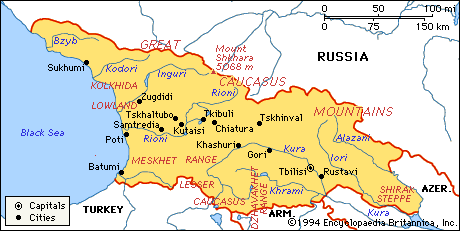 4L6PA
operated 70Km northwest of Tbilisi, Georgia
4L6PA
operated 70Km northwest of Tbilisi, Georgia
It must have been around November 1994, that Pim PAØTLX and I had one of our late night local chats on 50.250 MHz. There had been an interesting documentary on the Dutch TV that evening, made by a film crew that did an overland trip all the way around the Black Sea. The film crew visited Georgia and then crossed the border to Turkey. People were interviewed on both sides of the border and it was striking to see how different cultures can be at such a small distance away from each other. I myself had just been on holidays to the Turkish side of the border, which I spoke with Pim about in our QSO, and together we wondered how it would be like on the Georgian side. As a joke, Pim said "well, let's go there on DXpedition and see!". This was of course not a serious statement so we soon forgot about it. Much later, in 1995, Pim and I met again on 50.250. I can't really remember how we came to the subject, but Pim asked my opinion about REALLY going on a DXpedition. This was no joke, this was serious! I told him that you should try everything at least once in your life, so why not a DXpedition! To me it would be a great challenge, I said.
We started to think about which countries would be of interest for such an operation. It should be a country that is within the range of normal summer Es propagation from NW-Europe and preferably one from where six metres is not yet activated by amateurs. We started looking at the map and at the end of our QSO, we concluded that Turkey would be the ideal country.
In later QSOs we discussed with how many persons we should go, when and for how long. We decided that four persons for a period of two weeks in June would be the best, so we needed another two persons. In and around Amsterdam there are only few SixManiacs and everyone knows everyone. So it did not take long until Pim found two other amateurs who were basically interested in joining: Tjerry PBØANX and Kees PA3EQK.
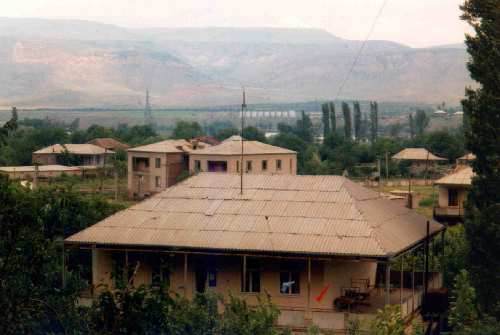 Omar's house with Kankasw mountains in the background.
Omar's house with Kankasw mountains in the background.
We had a meeting at Pim's where we discussed the rough plan about a DXpedition to Turkey. The first thing that's required for an expedition is of course a licence for six metres. We wrote a letter to the Turkish Embassy in The Hague and asked them whether it would be possible to obtain a licence for six metres. After many months, we got the reply that our request was regarded as 'inconvenient'. In other words, we could forget about getting a Turkish licence for Six.
It was January now, so we still had five months to go. Again we looked at the map and picked two countries: Albania and Georgia. At the time, Albania seemed easier as we got in contact with Henk PAØHTR who had visited the country several times for (satellite) DXpeditions. For Georgia, we had no connections so we looked in the international callbook and picked one name out of the 15 stations mentioned: Omari 4L5O in Tbilisi. We sent him a letter in which we explained him our idea and asked him if he could perhaps help.
Henk PAØHTR was willing to help us in trying to get a licence for six metres in Albania. He had some contacts there who could probably help, and he himself would also like to join the expedition. Meanwhile, another participant had joined the crew: Willem PD0OHW. He had never been active on six metres but he was simply attracted by the adventure of our expedition. Letters were sent, detailed plans were made, however, time flew by and in the end of April there were still no signs from Tirana that we could get an Albanian licence in time. We only had about six weeks to go, so we had to decide to stop further attempts for a DXpedition to Albania.
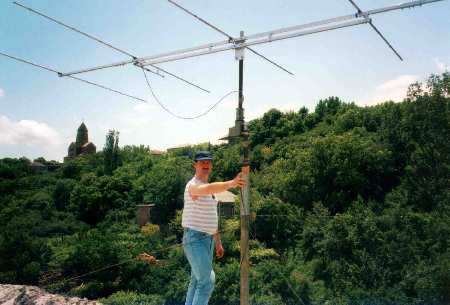 Tjerry, PB0ANX on the roof with the antenna
Tjerry, PB0ANX on the roof with the antenna
We had almost decided that a DXpedition in 1996 would be impossible until, all of a sudden, Pim received a fax from Omari 4L5O, in which he stated that he contacted the Georgian Ministry of Post and Telecommunications and that he could probably arrange a temporary group licence in Georgia! He confirmed that no six metre licenses had ever been issued before in his country. He asked us for what exact period we would need the licence and he even asked us what callsign we would like to have (he suggested to use 4L6SIX or 4L6PA). He also said that the authorities would not allow us to operate from his home in Tbilisi, because of possible interference on channel 2 of the local TV cable network. Instead he offered his second home where we could stay and which was a perfect QTH for the DXpedition! It was located in Metekhi, a small village 7km away from Kaspi, which is about 70km North West of Tbilisi.The license
We had to act quickly now. We immediately sent a fax back to Omari and
asked him to go ahead with the application for the licence, callsign 4L6PA. We explained
that in the Netherlands, amateurs are allowed to operate in the 50.000-50.450MHz portion
of the band in all modes, so he should try to get a licence for at least these
frequencies. We informed Omari some days later about our flight schedule. Then the
unbelievable happened: within a few days, Omari sent us a fax with a copy of the licence!
Publicity
Not many people new about our plan, and now we had passed the point of no return it was getting time to announce our DXpedition in various magazines, the packet cluster and of course on the Internet. The idea arose that a home-page on the Internet would be very useful for keeping the Six-community informed about the progress of the DXpedition. Some of the crew members did have an Internet connection, but none of us had any experience with HTML programming which is necessary for making web-pages. Fortunately, Frank PA3BFM brought us into contact with Enno PAØERA, who maintains a web-page called The Dutch Digital DX-Dungeon). We agreed to regularly issue updates, which he would put on the Georgia page. The announcement of the DXpedition was also put on the packet-cluster.
We immediately received many enthusiastic reactions from all over Europe. Some people told us they would even take some days off from their QRL, just to work us. We started to feel the responsibility resting on our shoulders now. There were still so many things that could go wrong, suppose we wouldn't be able to work them for whatever reason, then all these people would have been waiting for us for nothing?
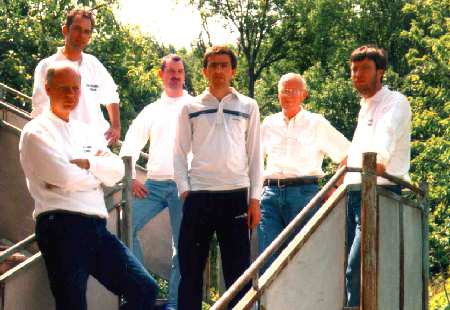 Left to right: Willem-PD0OHW, Allard-PE1NWL, Tjerry-PB0ANX, Omar-4L5O,
Pim-PA0TLX, and Kees-PA3EQK
Left to right: Willem-PD0OHW, Allard-PE1NWL, Tjerry-PB0ANX, Omar-4L5O,
Pim-PA0TLX, and Kees-PA3EQK
In order to minimise the risk of anything going wrong, we decided to carefully plan and check and double-check all factors of the operation which we could possibly have any influence on from Holland. Certain things, however, were not in our hands and we had to rely on Omari for making the necessary arrangements. Factors that we could arrange from Holland were:
The import/export licence for the Georgian Customs. We had to specify exactly what stuff we would bring to Georgia, including detail such as serial numbers etc. Omari went to the customs and sent us the required documents by fax. He said he would be waiting for us on the airport and help us with the customs clearance in case of any problems.
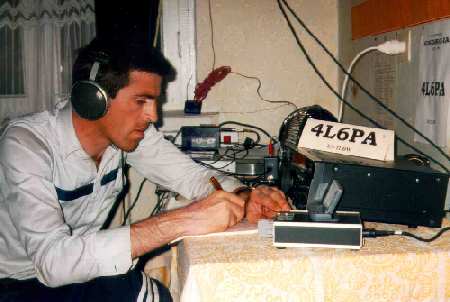 Omari operating the 4L6PA station
Omari operating the 4L6PA station
All of the above matters that we needed to organise, required extensive fax communication with Omari. We had the experience that he normally replied to our faxes within one or two days. We were therefore quite surprised that about three weeks before we would go, all of a sudden, no faxes were received any more from his side. We started worrying about this after a few days so we decided to send telegrams to his addresses in Tbilisi and in Metekhi. None was answered. We even contacted his QSL manager in Turkey and asked him if he had heard anything about his whereabouts, but he also did not know... We had almost decided to cancel the whole DXpedition when, just one week before we were due to fly to Georgia, we received a new fax from Omari. The poor guy had become ill and had to spend ten days in hospital where he had to undergo an appendix operation. He wrote that fortunately he had recovered completely from his illness and that, as far as he was concerned, there was no reason to stop the operation. One can imagine what a great relief it was for us to receive some signs of life again!
The journey began in the morning of June 14th, when we went to Schiphol Amsterdam airport. The customs clearance there took us about 15 minutes, thanks to the pre-prepared documents. Would it also be that easy at Tbilisi airport? Our Tupolev took off in time and during the four hour flight we met with the first Georgians (we were the only Dutchmen aboard) who told us some about their country, a country that they are all very proud of.
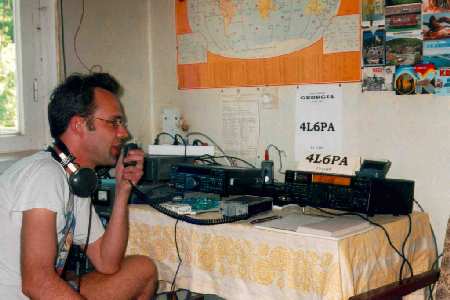 Allard, PE1NWL, operating 4L6PA
Allard, PE1NWL, operating 4L6PA
Tbilisi's airport has an old building of Soviet architecture with an almost colonial atmosphere. Omari awaited us, as agreed, in the arrivals hall. We were warmly welcomed by him and, thanks to him, we went through the customs in no time. A van was waiting outside that took us on the two hour drive through the mountains to Metekhi. Apart from the driver, there were two extra men on the front seat. "Extra security", said Omari, when we asked him why they were accompanying us. We arrived safely at Omari's house where his sister Lia awaited us with a nice dinner, consisting of cold chicken, salad, beer and vodka. After dinner, we presented Omari's new toy: the Kenwood TS-690, which he enthusiastically unpacked. The shiny Japanese rig was of course something quite different from the home-brew transceiver he had always used so far. Soon after this the electricity went out, candles were lighted, and outside in the pitch-dark, we enjoyed the Georgian sky with millions of stars, something one cannot see any more in Holland.
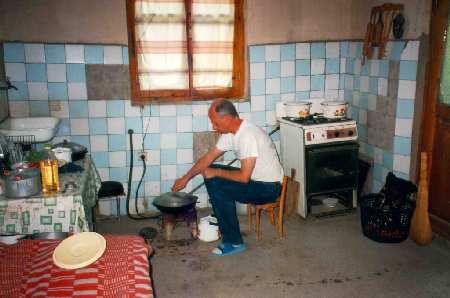 Willem, PD0OHW, in the kitchen!
Willem, PD0OHW, in the kitchen!
The first thing we did in the morning, of course, was to have a look around and see what the surrounding area was like. Omari's house was built on the northern slope of a hill; take-off to the south was therefore expected to be poor. To the north we could see some small mountains in the distance, but they were too far away to expect any trouble. To the west and to the east, no mountains could be seen so take-off to Europe couldn't be better! There was only one big tree east of the house, but we did not expect to have too much trouble with that. Besides, we did not expect to make many QSOs in that direction. Omari told us that the village was at an altitude of about 500 metres above sea level.
The area was very green, although it was dry and sunny that day, one could see that it rained often. The climate was very pleasant and Mediterranean-like, with temperatures of about 25°C during daytime, and a cool 15°C at night. Omari's house was a two story high concrete building, with a veranda on the south side. The rooms on the ground floor were not in use, except for the kitchen, where Lia was already busy preparing the breakfast. Upstairs, there were three rooms: one large room which we had used that night as bedroom, and two smaller rooms. We would use one of these rooms as the shack, so we installed the two rigs on two separate tables there. The coax and rotator cables could easily be fed through a window. There were some comfortable chairs and a couch in that room as well, ideal for the exhausted operators who need to recover from pile-ups.
After breakfast, we examined the situation on the roof. A short pipe was already mounted on the roof (Omari had used this before for his own antennas), in which we could easily stick our own mast. The only thing we needed to do was to attach some lines to the mast and the roof for extra support. The situation was perfect! Within a few hours we had mounted rotator, erected the mast and beam, soldered plugs to the coax cable and connected the rig. The beam was about two metres away from the roof. At that time there was still no electricity and the generator hadn't arrived yet, so we could not yet test the station. We therefore continued with installing the HF antenna, which we could easily tie to a tree in the back of Omari's backyard. We decided to use the Kenwood TS-690 for our daily contact with Bert on 20 metres, so that we would not have to interrupt six metre operation for this. Later that morning the generator, borrowed from Omari's neighbour, arrived. It was an old two-stroke engine from the Russian army. Because it was very noisy (it virtually had no exhaust pipe) it was decided to place it behind the house, as far away as possible from the shack. With some effort, Omari's neighbour managed to get the machine running and we immediately ran to the shack to test the station. When we switched on the receiver, we found a 50MHz band as clean as we had never heard it before. No computer whistles, no QRM from nearby TV transmitters, no QRM from the generator, just noise, pure white noise! But no stations could be heard either. Pim almost couldn't believe his ears and he even started to doubt whether he had assembled the beam correctly. But the SWR was normal, so the band must simply have been dead at the time. We switched on our beacon at 50.123 MHz for the first time at 1032z. 4L6PA was on the air!
In the afternoon, the car arrived that Omari had arranged for the period of our stay in Metekhi. It was a Lada (of course) and to our surprise the rental fee included a driver. We very much appreciated having him with us during the trips we made with this car, driving in this country is an art in itself that requires special skills that we lack. He turned out to be a good car mechanic as well, which can be useful when you are driving a Lada.
That afternoon we used the car to go to the market in Kaspi, to stock up some food and other essentials as beer, vodka and Coca Cola. The rest of the day the band remained dead, so we couldn't participate in the UKSMG contest that was held that day. At 1800z we had our first contact with Bert on 20 metres. He peaked 59 with us, we were only 55 in the Netherlands, but this was good enough for our purpose. We were all happy that we could inform Bert that we had arrived safely, that Omari was a perfect host and that the six metre station was up and running! To celebrate this we had an extra beer and vodka that evening and toasted to the band openings that we were to come.
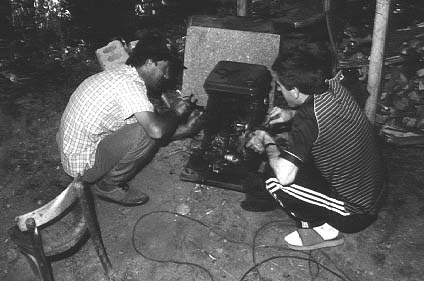 Omari and his neighbour fixing the generator.
Omari and his neighbour fixing the generator.
We started the beacon at 0410z and waited. Nothing happened. After some time we started to call CQ on 50.110, beaming NW to Europe. The white noise that we had heard the day before was still present. No video carriers, no beacons, nothing. Until 0910z, when Kees heard a weak CW signal. He turned the beam, the signal came almost from the south. It was 4X6UJ that we made our first QSO with. Of all directions, our first QSO was to the south, the direction that we thought would be most difficult! This proved that the hill south of us was not really a big obstacle for our signals and with even greater enthusiasm Kees continued to call CQ.
Seven minutes later, at 0917z, we worked SV1UN, followed by SV1DH. At 1014z we heard Cedric CT3FT and we worked him on both CW and SSB! This was major DX, and we thought to have already worked our best DX for this expedition. Taking the poor conditions over Europe into account that we had seen in the past weeks, what other countries could realistically be worked from Georgia that were farther away than CT3? We thought none. YO7VS/P popped up at 1029z and LZ2HM was worked at 1042z. YO2IS at 1043z was the last station we could work that day.
The electricity was working in the morning and the beacon went on the air at 0400z. No signals could be heard. Willem and Omari went to Tbilisi by car for the reconfirmation of our flights back to Holland and to do some shopping. At 0800z, the mains electricity went off. We tried to start the generator but we couldn't get it running. Valuable time was lost in this way, until the mains electricity went on again at 1500z. However, there was no propagation any more for the rest of the day.
After dinner, Omari's neighbour came to examine the generator. The electrodes of the spark-plug were completely covered with a black oily substance, probably because of mixing too much oil with the petrol. The smoke coming out of the exhaust pipe was deep blue and the ground under the exhaust was covered with oil. We tried to convince him to use less oil, but he insisted to keep using the same oil/petrol ratio. Well, it was his generator, so who were we to tell him what would be best. But we kept feeling a bit insecure about this apparatus which was so vital for the success of our project. We therefore decided to run the station on the generator that evening (although the mains electricity was on at the time) just to make sure it was really working normally again.
Immediately after switching on the receiver in the morning, we heard the Greek beacon SV1SIX, but no other signals were heard. At last, at 0900z, we worked SV1AHX with weak signals. At 0912z we worked Manfred SV5/DL8SET.
Nothing happened the next 30 minutes or so, no beacons could be heard any more. Omari looked at his watch and said: "this is the right time for Japan!". Already before we had talked about working Japan, Omari thought this should be possible but we had always been very sceptical about this. But this time, we smiled and said "OK, why not give it a try, let's turn the beam north east". So we did, Omari called CQ only once and to our great astonishment, we immediately heard JA6QGG in PM73 booming through the speaker! The QSO was complete at 0944z, both in CW and SSB. Some minutes later we were able to work JA6IMJ in SSB and JA5GJN/4 in CW, with good signals but lots of QSB. Omari smiled triumphantly: "I told you, I told you". JK6PAC was also heard on SSB, but unfortunately the QSO was not complete. This was super DX that we had never expected to be possible and it was even farther away than CT3! Our excitement slowly diminished when we started to think: "If JA and CT3 can be worked so easily, then why didn't we so far work NW Europe? The station itself should be OK, but are those mountains in the distance perhaps too high? Is there anything else that disturbs our take-off to the NW?" The only thing left that we could do to improve the station was to put the antenna a bit higher, as we hadn't used all of the mast elements. The beam was currently only 2 metres away from the roof, and the roof contained a steel framework which could possibly influence the radiation pattern of the beam, we thought. In the afternoon we added 2 extra elements to the mast, thereby raising the antenna by 2 metres so that it was now 4 metres away from the roof.
The rest of the afternoon we didn't hear any signals. At 1600z we had our daily sked with Bert and Cor on 20 m, and to our surprise they already knew about our QSOs with Japan that morning. News travels fast, especially since many amateurs have an Internet connection. Dinner was served in the room next door, and as usual we let our full break-in beacon running continuously on 50.123 MHz and left the door to the shack open so that we could hear if someone would try to break-in. We had almost finished our dinner when we suddenly heard a weak CW signal breaking-in. We ran to the shack and heard Bert, PA3DWD again, this time not on 20m but on Six! With him we made our first QSO into PA on 1757z. Immediately after this we worked the first German station DK2PR (also 1757z), followed by another two dutchmen, PE1LCH and Cor, PAØCOR, in the next two minutes. After this the band closed completely again. It was a very short opening, but we had now proven that there was nothing wrong with our station, and that we only had to wait for better propagation to work more European stations. In the evening, we watched the football match England v/s Netherlands in the European Championships. Omari had a B/W television, but he didn't have an antenna for it.
As the band had closed completely and we did not expect any signals any more (especially not from G and PA), we decided to use our six metre beam as TV antenna. The commentary was in Russian, a language that we were all not very good in (except Omari), but we found out that the match was also being broadcast live on the Dutch World Service which we could of course easily receive on the Kenwood. Radio amateurs always have solutions for everything. The result of the match, however, was something we unfortunately did not have much influence on: England won 4 - 1. To take revenge we decided not to work any G stations that evening.
 Allard and Omari inspecting his new Kenwood!
Allard and Omari inspecting his new Kenwood!
In the morning we heard some video carriers coming from the South West. We worked SV1UN and later, at 0619z, we heard the 5B4CY beacon, but no other activity could be heard from Cyprus. At 0625z we also heard the OD5SIX beacon, but also from Lebanon unfortunately there were no stations active. Two hours later we worked 4Z5JA and 4Z5DB, who were the only stations we could work in the Middle-East. At 1600z we congratulated Bert on 20m with his first to Georgia. He told us he heard our beacon and that he only called us twice before we returned. Bert, who lives in the extreme northern part of The Netherlands, had also spoken with many other SixManiacs in other parts of the country. It seemed that the opening had been limited to the northern areas only which explains why we did not get a tremendous pile-up from PA.
Early in the evening, at 1747z, we were able to work S59A, followed by S52ZW and S57AC. Later that night, Omari had a QSO with a Georgian station on HF who was located about 40 km away from our QTH. He said he had an old Russian army set for 50MHz. He already had it for five years but he had never used it. The thing weighed over 200kg and had 20W output in FM. He had only a long wire which he could use as antenna. Omari asked him to try a QSO on Six, and 15 minutes later we were able to work him on FM. It was the first QSO on six metres he had ever made, he said. Hopefully this experiment contributed to the spreading of the Six-virus in Georgia.
Since our QSOs with Japan two days before, we tried every morning to make more contacts to the Far East, so far without success. But today we worked VS6XMT in Hong Kong in SSB with weak signals and again lots of QSB. The whole QSO took several minutes, but we finally made it complete at 0619z. About 40 minutes later we were again able to two Japanese stations: JR6HI (CW+SSB) and JR6VSP (CW)! At 0700z the band opened to Greece (SV1EN, SV1DH, SV1AHP) and later to the Balkans. Several 'firsts' were made this morning, starting with 9A2DI at 0810z and ER5OK at 0945z. In the next hour we worked some other well-known ER-stations: ER5DX, ER5AA, ER2GF, ER5WU and ER5AL. The first Italian station, IK0FTA, was worked at 1134z, immediately followed by Z32FC (also at 1134z).
At 1247z we worked SP3UCA and at 1318z OM3PC. It may seem that all of these stations were worked in one big opening, but it actually consisted of many very short openings that each time allowed us to work only one or two stations. Our full break-in beacon was of great advantage, by using this method we did not miss these very short openings. Other stations worked this morning were YO2IS, YO7VJ, LZ2KWW, YO7VS, I4XCC, OM3KFC, I5MXX, I4LCK and OM3KFO. We remained QRV for the rest of the day but we could only work one more station: YU1EU at 1935z.
Tjerry, who could join the DXpedition only during the first week due to other commitments, had to fly back to Holland today. Pim, Omari and I took him to the airport in Tbilisi in the morning. When we said goodbye to him in the departures area, we thanked him for his contribution and we all hoped to be able to work him in the coming week. Tjerry was quite sceptical about this as he had only 15W output from his set at home, but he promised he would try anyway. After Tjerry had disappeared in the waiting lounge, we were all a bit jealous for a short while: he was the only one of us who could work 4L. It had been very hot in Tbilisi, but when we returned in Metekhi it was raining and cold, only 17 C. Kees and Willem, who had stayed home, informed us that they had finally worked the first G and GJ stations! They had heard the OD5SIX and the 5B4CY beacons again in the morning, but the only QSO was with 4Z4UR. Then, at 0932z they worked G4JCC, G3FPQ, 9A2DI (!), G3KNU, GØNYL and PE1LCH. The band closed for about an hour, until at 1204z GJ4ICD was worked. All QSOs were in CW with reasonable signals. After this, no other stations were heard that day.
Until today, we had made about 75 QSOs in six days. The openings had so far been very sporadic and short so that we did not have any real pile-ups. Today it went much better. The beacon was activated at 0555z but nothing was heard until 1002z, when we could work RA3YO on CW. 9A2DI and YU1QC were also worked and then it happened: at 1023z it was PAØRDY whose strong signal paved the way for practically all the other well-known Dutch stations: PAØJMH, PA3GML, PAØERA, PA3BFM, PA2TAB, PA3FYM, PE1MHO, PE1OUC, PAØLSB, PE1NTE, PE1NGK and.... Tjerry PBØANX! (just one day after he returned to PA!).
At 1154z we worked HA8BE and at 1223z we worked Arne, SM7AED. Three minutes later, at 1236z, we had our first QSO with Belgium, ON9CFB, at 1354z the first with Sicily, IT9PMZ, and at 1432z the first contact with Belarus, EW1AA.
Other stations worked that day: G4IFX, ER5GB, IØJX, S59A, SM7FJE, DL6NCI, ON4ANT, DK9KX, YU1AU, YT1AU, S59DRA, IKØFTA, IKØBAL, IK5QGO, I5FLN, I4CIL, IK4DRY, IK4BHO, SP5SS, SP5XAB, SP9HWN, IØIKY, YT1AUI, YT1IK, IK1EGC and YU1NW. The band closed at 1531z and only opened again very briefly at 2147z, when we worked IK2GSO. During the evening we noticed that Omari, who had so far been quite sceptical about the possibilities of working very much on Six, began to show a little more enthusiasm for the 'magic band'. This is what we had been waiting and hoping for and after an incubation period of about a week, the Six-virus had infected Georgia!
Today happened what everybody was waiting for: a big opening to Europe with real pile-ups. Omari became more and more infected by the Six-bug. During the many CW-QSOs he turned out to be a perfect pile-up handler who operated the CW-keyer with Kalashnikov speed! The beacon was activated at 0615z, and already at 0641z, it was SM7AED again, who opened the DX-hunt. A big opening had started that would last till 1004z; during this three hour opening, six 'firsts' would be worked: UXØFF at 0646z, OZ1IEP at 0721z, OK9NI at 0739z, F5JKK at 0745z, GWØGEI at 0805z and EH1DDU at 0914z. The pile-ups were killing and we had to change operators every 30 minutes or so, just to prevent them from getting totally exhausted. We almost did not have the time to fill the QSOs in our log! The weather had changed and it was 35 deg C that day but the set remained remarkably cool. The extra fan we had brought for additional cooling was not required. Apart from above-mentioned firsts, we worked following stations during this first opening today: OM7SM, SP4MPB, HA6ZB, HG6QX, SM7CMV, SM7BAE, OM3PC, OZ4VV, SP9MRT, SM7SCJ, OZ1LO, OZ8RW, HA8BE, SM6CO, OZ8ABE, 9A5I, YU1VG, YU1QC, OZ1LO, SM6CMU, OZ8RW, YO2IS, OZ5AGJ, F8OP, OZ6OL, OZ2LO, OZ3ZW, DF9CY, 9A5I, YO4BZC, OZ4D, OZ9CLN, DJ4SO, OZ9NI, DJ6TK, GW4VEQ, YO7VS, DJ9YE, PE1LCH, PA3DOL, YU1AD, DL8HCZ, DL5BAC, PE1NGK, DJ8ZJ, DL9XAT, G3KOX, PE1OZH, G4FVP, PE1LAU, PE1MCD, G4WND, G6HKM, PA3GSU, DK2PH, DL7AV, G4BWP, PE1OOY, GØJHC, SP6HEI, PAØHIP, G3SYC, DF7VX, GW3VXH, G3WOS, G3MCS, G4AJC, G4AFJ, G4SEU, DF7VX, PE1MHO, ON4GG, PE1OGF, PE1MZS, ON7YD, DJ6NI, GW3LDH, G8DVR, ON4KST, DL8PM, F1GXV, GW0VSH, ON4PS, ON1APG, ON4ANT, DJ3TF, G4RGK, PA3DYY, PAØLPE, ON1IM, PE1AEB, ON1ARQ, DL7QY, PE1PHQ, ON7EG, PAØLSB, PA3GST, PA2CHR, PAØION, PAØERA, PAØBMS, PE1PZS, GJ4ICD, ON1BTH, SV7AII, GJ8ORH, SV1OH, SV1WE, IKØOKY and IØJX.
But that was not all! After having worked all these stations, the band closed for about two hours, giving us time to wipe the sweat from our foreheads and to recover from all the excitement. But the sporadic E had no mercy: at 1203z the band opened again for another two hours, this time to S Europe. During this second opening, we worked another first: 9H5EE at 1227z. Later he told us that he could hear us for several hours after this QSO and that he had tried to warn his other friends on Malta, but unfortunately he couldn't reach them so he remained the first and last 9H-station we worked from Georgia. Other stations worked during this second opening were: I4SJX, IK4BHO, I3LLH, IK3TPP, S57A, I3LDS, SV8QG, I5MXX, IK4RDY, S59YL, IK2QEI, IK3GHZ, ER5OK, I3LDS, LZ2UU, I2AOX, LZ1KDP, IK2QEI, I5FLN, IK3OCD, IK3HAR, IK4CNQ, I3RSP, I4LCK, IK7XGD, IK3GLD, I7CSB, SV2BZQ, S59F, S53X, and I7CIB.
At 1410z the band closed again with only LZ2HM worked briefly one hour later. At 1530z we had again our daily sked with Bert and proudly we could inform him that we had made approximately 150 QSOs. We were all very happy that at last we had had a big opening that allowed us to work many stations with moderate output power and that also the ones who were not capable to do CW had a chance (until today, most QSOs had been in CW).
We did not know yet that at that moment we were only halfway! Already during our sked with Bert, at 1548z, the band opened again to Germany so we quickly finished the QSO and concentrated on Six again. This third opening lasted three hours and enabled us to work yet another 130 QSOs and 3 new countries: OH3NLP at 1627z, LA8WF at 1652z and OE6BMG at 1659z. The first 18 QSOs were CW, the rest were nearly all SSB except for the last ten or so, when the band slowly closed and the signals went down into the noise at 1847z.
The following stations were worked: DL3AMA, OK1DDO, DL2VPO, DL9USA, DL7QY, DJ4AX, DJ5JK, DL2GBT, DL8SET, SP6GZZ, DL9GS, DJ9KG, DL6UCW, OK2BDS, SP6RLA, DL8ANR, OK1DDO, DL9USA, DJ4AX, DJ4PI, DF5LT, Z32BU, DK7YY, DL7YS, I2AE, SP6WAS, OK2DB, OK2XTE, SM4POB, SP2NJE, DJ3TF, OK2HBR, SP6VWM, DK7ZB, SP6CPH, DF4IE, DF3FJ, DFØLI, SP2SGZ, IK7VJY, SP2HNF, OH1VR, YZ1SM, PE1AGJ, SP5XMU, SP5CCC, SK7NM, DK7SP, DJ6AM, OK2TT, DL8YRM, DL3HRM, SP9MRQ, SM2EQY, 9A3MZ, OH1MMM, DL2HWA, S53BB, SMØFMT, SP6BRQ, SP6TRQ, DK3RV, OH3AAY, G8GXP, SP9UPK, OH1LEU, G4CCZ, OE5OLL, SM9MCY, SP6CRZ, SP5VIQ, DL4AVI, SP6PCL, DL2HZM, G4KUX, 9A2TK, SMØAJU, G3NSM, SM5SMH, SL0ZG, DL4ALI, SP6WAS, G3HBR, SMØVDA, SMØKAK, DF6NA, SP6GWB, SM6FHZ, G6LUK, OH1AYQ, DK2EA, LA9DI, G6YIN, DF6BFQ, PAØFHG, PE1MJV, OK2PPP, OH3XA, SP5VIQ, PA3GDN, DL9NDF, OZ1DJJ, SP9DSD, SM7DTT, PA2VST, PA3FBN, PE1PJG, PAØLOU, SP9GPW, PE1KXH, SP2HNF, SP2IQW, DLØHEL, SP7ARF, SP2HRF, S51GW, ON4PS, ON4AOI, S51UF, OZ1DOQ, 9A3AT, SP7RFE, SP7BCA, SM6FHZ, G3ZYY, DF5LQ, DJ1JO and DKØIG.
Totally exhausted, we celebrated today's success with Georgian wine, beer, vodka and caviar which we had found on the local market of Metekhi. We discussed the highlights of the day and replayed the recordings of the pile-ups we had made on a small cassette recorder. Omari was now fully converted and had become a real SixManiac.
As is often the case after a big opening, the band was dead the following day. Although we were continuously QRV from 0545z onwards, we could work only three stations: YU1VG, YU1ICD and YO7VJ. The mains electricity was off so the generator had been running all day. At the end of the day we measured the fuel consumption of that day: 21 litres of petrol, which makes seven litres per QSO! The SV9SIX beacon was logged at 1136z, but again no activity was heard from Crete. In the course of the day we noticed that the generator had started to give less power. We could now run only one set at the time, whereas before it was no problem to transmit on both sets simultaneously. Also the motor stopped several times but we could get it running every time again. Omari went to his neighbour to ask him to have a look at it, but the man was not at home.
The beacon was started at 0553z but we had to wait till 0800z, when we worked SV9ANJ, the first station from Crete. In a short opening to Israel we worked 4X1IF at 0830z. At 0935z the band opened towards shortly to Germany and we worked DL9UDS and DL9USA. Also the 4N1SIX beacon was heard and also lots of video carriers from the south east, but there appeared to be no activity from that direction. The band closed at about 1100z, we could not hear any more beacons or video QRM. Then the generator stopped.... No matter what Omari tried, he couldn't get it back to running again. We suggested he should dismount the cylinder and the exhaust pipe and clean them internally, but Omari insisted to wait until his neighbour would arrive. Valuable hours went by, but the neighbour still did not return. Fortunately, the mains electricity went on again at about 1430z, so we could continue our game for the time being. Hopefully we hadn't missed too many openings in the 3 hours that we could not be QRV. Anyway, at 1519z the band opened again and stayed open until 1952z! Thanks to this opening we made our first (and last) QSO into EA6 at 1647z, with EA6/OK1GW, and we worked the first station from Switzerland, HB9DBM, at 1923z.
Other stations worked were: DL2GBT, SV2KD, DF3GY, SV1DH, F6CC, F1AKE, YO3OAC, DL8FBO, DLØIG, OE5PAM, Z32BU, SV1UN, DK2EA, EH1EBJ, SV8QG, YU1EU, Z32DR, YO3DAC, YU1AU, S59D, 9A2DI, S52CO, S57C, YT1AU, SP6TRQ, I5HDG, I1EQR, SP9SOI, I5FLN, IK3GLD, F1MXE, DF3GY, G3KOX, G3HBR, G3NOH, G3NVO, G1IOV, G4MKF, G4DEZ, G3FPQ, G4IGO, G3IBI, G8VOI, G8BQX, G1RMN, I4SJZ, SP8MMZ, G1IOV, G3IBI, GØOFE, G4JHM, GØRRJ, G4UPS, IØCUT and IK2GSO.
Not bad after all! It was fascinating to see how quickly the openings jumped across Europe today as one can see from the prefixes above. We stayed QRV until the electricity went off at around 2100z. We lit candles and discussed what to do about the generator problem. We had still two days to go, the neighbour had still not returned and we did not want to lose more time.
We discussed following options: 1) rent or even buy another generator. There were no other generators in Metekhi and getting one from Tbilisi would cost us one complete day and would be very expensive; 2) Use car-batteries. We didn't have a battery charging device. 3) Go to the local power station and try to convince the person in charge to leave the electricity on for one day, allowing us time to fix our own generator. We chose to try this possibility and then went to bed, although for some of us it was difficult to fall asleep.
 Omari, Willem, and Kees setting up the 6m beam
Omari, Willem, and Kees setting up the 6m beam
When we woke up in the morning, we noticed that Omari had left the house, he was probably on his way to the power station. There was no electricity, so we killed the time by preparing a breakfast with omelettes. Pim was just making his famous coffee when suddenly the lights went on! This was very unusual for this time of the day, Omari must have had success at the power station. We immediately switched the equipment on (0630z) and heard the SV9SIX beacon, but there were no other signals to be heard. Omari returned home about an hour later, and smilingly he told us he managed to find the person in charge at the power station and that he could convince him to leave the electricity on for one full day.
Unfortunately for us there was almost no propagation that day, (we only able to work 9A2DI and YU1NW at 1257z) but the rest of the villagers must have been quite happy with all the electricity they got that day. Omari's neighbour returned home in the afternoon, and he and Omari disassembled the whole motor of the generator. As we had expected, the cylinder and the exhaust were full with a black, oily substance which was difficult to remove. But they managed to clean everything and to our great relief they got the motor back running again for us!
In the evening we told Omari that we had seen he had become enthusiastic for the magic band. We once again asked him to continue six metre activity after we had returned. To encourage him even more, we had meanwhile decided to leave the five element beam, the rotator and all cables behind, so that he had a complete six metre station. Omari said he could most probably arrange a six metre licence on his own call and he promised us to be QRV as soon as possible. The only thing he still needs is a good power supply or some 12 V batteries, but we estimated that that would not be too much of a problem for him. He promised he will let us know as soon as he is QRV, so that we can inform the Six-community in Europe.
Kees and Willem went with Omari to Tbilisi. Pim and I stayed in the shack. The electricity was still on in the morning, so we put the beacon on the air at 0756z. The band opened at 0830z to YO2IS. Our break-in beacon helped us again not to miss the many short openings that followed. At around 0900z we heard a strong signal on the back of our beam. We quickly turned it south and heard 9K2CA having a QSO with IK8DYD. After they had finished we called him immediately so that we could log him at 0908z. He was the first (and last) station from Kuwait. Omari, Kees and Willem returned from Tbilisi. They had done some shopping and bought some gifts and souvenirs: vodka, caviar, picture postcards etc. Omari gave everyone a small collection of Georgian stamps.
At 1132z we worked ISØQDV. At 1600z we had our last sked with Bert and Cor on 20 m, in which we thanked them for all the support and the nice QSOs we had had with them. Immediately after this we removed the HF antenna and started packing our luggage, leaving Omari's new Kenwood on the six metre beam, so as to remain QRV as long as possible. The last six QSOs we made used this set with 50W output power. Other stations worked on this last day were: OZ6ABA, PA3FBN, PE1KLQ, SMØAJU, RA3YO, PE1LCU, OZ7DX, ER5OK, YO9FDC, OZ5AGJ, CT3FT (again, now in SSB!), Z32FC, IK8MKK, IK8DYD, I2ADN, YU1AU, 9A5I, SP9SOI, LZ2HM, CT3FT (and again! now S9+ in CW) and YZ1SM. The last station that this DXpedition worked was OE2UKL at 1801z. At 1903z we switched off the set. 4L6PA was QRT.
Late at night the van arrived that would bring us to the airport the next morning. It got stock in the mud in front of the house (it was a real expedition, after all), but with the help of the whole crew we managed to push it out. The driver slept that night on the verandah, while we, melancholically, finished the last beer and vodka.
Omari brought us to the airport in Tbilisi. A new airport building had just been opened where we had to check in for the flight to Amsterdam. Omari accompanied us until we had passed the customs. After this we had to say goodbye to this man who had helped us terrifically. After we had expressed our thanks for his help and his great hospitality, he said he had enjoyed the DXpedition very much. Before we split, his last words were "See you again on Six!". When we arrived in Amsterdam, Tjerry was waiting at the gate. Via him we got the first enthusiastic reactions that he had received via packet, Internet and in QSOs with other stations. We slowly started to realise that the operation had been a great success. When I returned home, I found my e-mail and packet mailbox full with messages from all over Europe and even some from Japan and Hong Kong. Most of the senders reported enthusiastically how they had worked us or how difficult it had been to work us, some were disappointed as they had heard us but for some reason could not work us. Arvo ES1CW, for example, sent me a message via packet in which he reported that he had heard us for a few minutes, but could not work us. He suggested that a good reason for the fact that we did not work any ES-stations, could well be that the opening coincided with the mid-summer celebrations in the region so that most amateurs were not QRV.
It was very nice to see how Enno had filled the Georgia-pages on the Internet with updates as they had been relayed by Bert, briefly describing all the highlights. Thanks guys for all of your effort, you did a marvelous job. The photos that Willem and Tjerry had taken were developed and printed immediately. Some of them were sent to Enno, who put them on the Georgia-page as the final update. It was also very interesting to see how other web-pages had reported our DXpedition, some of them even allow you to download some sound-files. If you have a sound-card in your computer, you can listen to the signals as they were received in the UK (on the UKSMG home-page at http://www.uksmg.org) or even in Japan (on the WaiWai Ham Life page at http://www.big.or.jp/~ham/index-e.htm). This is the age of communication: go on a DXpedition and hear, immediately after returning home, your own signals as received at the other side of the globe! Amazing.
There are a few lessons we learned during the preparations and our stay in Georgia, which could be useful advice for anyone going on a DXpedition in the future. First, from the beginning we should have tried to contact local amateurs, who can help with the licence application, rather than trying to do it ourselves. Our first two attempts (Turkey and Albania) probably failed for this reason, but once we had found Omari, it all went very fast. We did not have many technical problems, the one problem we had was the generator. A good and reliable generator is of vital importance in a country such as Georgia. Looking back, I think it would have been better if we had taken one with us and paid the excess baggage to save our down time.
The concept of our full break-in beacon was very successful. In this way we did not miss the many very short openings, that allowed us each time to work one or two stations. I can recommend this method to everybody going on future DXpeditions. Some people however did not know about the break-in possibility. It happened that certain stations heard our beacon and waited, without knowing that they should break-in to activate us. As this was (in Europe) a new phenomenon that not many people were used to, we should perhaps have announced this more clearly. The memory keyer which we used for the beacon did not have the possibility of programming a pause in the beacon text; a keyer with this possibility would have been better for this purpose, as we could have listened during the pauses instead of in between the dots and dashes. Looking back at the operation, I think we may conclude that the DXpedition was a great success. All of our targets were realised: we brought a new country to life on Six; we made firsts with 41 countries; we made over 500 QSOs with not only the 'big guns' but with many moderate stations in Europe as well; we left a complete station behind so that six metre operation can be continued after we returned; and, most important, we ourselves had an exciting trip and a great time in Georgia.